

| Eakring Birds |
| Systematic list and summary 2008 |
| 2008 ended with the area
year list on 129 species. This placed it midway between
the record year of 2003 (140 species) and 2006 (120
species) The year produced a surprising three new species
for the area, with Red-breated Merganser, Nightjar and
Raven all occurring. If not notable for it's range of species, 2008 once again proved that with persistant effort, farmland habitat can provide a surprising range of species, whilst visible migration watches can provide both species and numbers. 2008 was by no means an exceptional year for migration and work commitments meant that the peak mornings for several species were missed. This especially applied to continental migrants making North Sea crossings. Although both Fieldfare and Redwing did provide four figure counts in October, totals for many species were lower than would have been expected. |
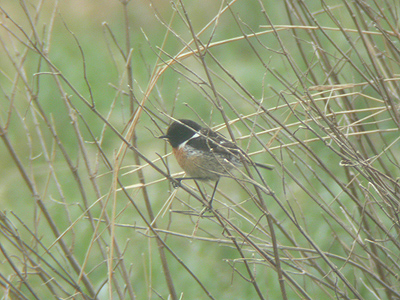 |
|
| ......... | ||
| Breeding
birds survey The first survey to cover every breeding species in the Eakring and Kersall area since 1998, went very much against the national trend of decline in the fortunes of several species, whilst it highlighted a decline in more unexpected species. Once again, particular attention was made regarding threatened farmland species, but it pleasing to report that several still continued to do well in 2008. Wildfowl counts Yet another very poor year, especially during the Autumn and first part of the Winter months. In fact Teal had their worst year ever here, but there were good numbers of Wigeon noted in January, although these birds spent most of their time on Bilsthorpe Pit Top. The poor Summer led to very few broods of any species. |
||
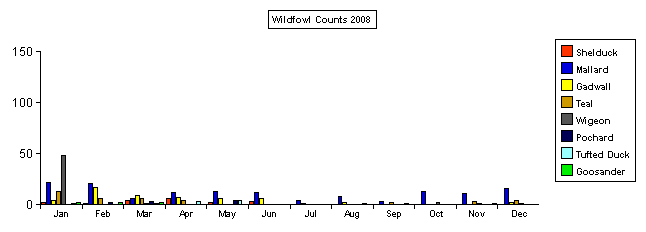 |
| The systematic list follows that used in the British Birds List of Birds of the Western Palearctic (1997)... |
| Cormorant Phalacrocorax carbo carbo |
| Recorded on numerous dates throughout the Winter months. Birds occasionally fed at Eakring Flash, but most records involved 1/2 birds returning to Trent Valley sites after feeding excursions around Bilsthorpe Pit Top. Four moving north on February 10th was notable. |
| ......... |
| Grey Heron Ardea cinerea |
| Commonly recorded, usually with at least one bird in almost continual residence at Eakring Flash throughout the year. |
| ......... |
| Mute Swan Cygnus olor |
| A pair were present for much of the first part of the year. No breeding attempt was made during the Summer. In the Autumn, what is presumably the same pair returned to Eakring Flash and remained on and off till the end of the year. |
| ......... |
| Whooper Swan Cygnus cygnus |
| There were two records during the year, with ten west over Eakring Flash on the afternoon of the March 26th and three adults east over Eakring Flash on December 20th. |
| ......... |
| Pink-footed Goose Anser brachyrhynchus
|
| There were no records during January or February. In the Autumn, the following skiens were recorded. 72 very high south-east over Eakring Flash on October 16th, 33 west and 78 north-west on October 30th, 250 south-east over Eakring village on November 6th and c90 east over Penny Pasture Common on December 24th. |
| ......... |
| Greylag Goose Anser anser |
| Noted occasionally during late March, through to May, when breeding birds tend to over fly the area. The only notable count made was 21 on September 18th, with most sightings involving singles or pairs during the early part of the year. |
| ......... |
| Canada Goose Branta canadensis |
| Only noted occasionally during the course of the year. A pair bred near Kersall. |
| ......... |
| Shelduck Tadorna tadorna |
| Two at Eakring Flash on January 26th were the first of the year. A drake was at Eakring Flash on February 9th, then pair there on 28th. The same pair were virtually resident at Eakring Flash on numerous dates during March, with higher counts being four on March 6th and three on March 29th. An unusual count of six were at Eakring Flash on April 3rd. There were no further records after May, Shelduck always disappearing after the breeding season. |
| ......... |
| Wigeon Anas penelope |
| 48 flying around the Red
Hill area on January 4th, was an exceptional record and
traced to a larger area of water on Blisthorpe Pit Top.
35 were again noted the following day (January 5th).
Wigeon have become very scarce at Eakring in recent years
and this count represents the second and third highest
counts for the area, since a flock of 60 flew west over
Eakring Flash on September 11th 1999. Three Autumn records was a good showing on recent years, with a pair of west over Eakring Flash on October 30th and single drakes at Eakring Flash on November 15th and December 25th. |
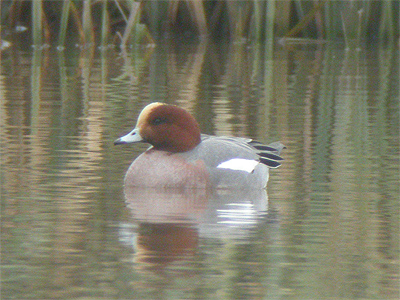 |
|
| ......... | ||
| Gadwall Anas strepera |
| The first of the year returned to Eakring Flash on Jan 16th. A count of six at Eakring Flash on February 3rd, rose to a maximum of 17 on February 13th. Just two pairs bred at Eakring Flash. |
| ......... |
| Teal Anas crecca |
|
| Another poor year, with four at Eakring Flash on February 28th and a pair remaining in the area until April 24th. There were just isolated records of single birds at Penny Pasture Common in October and counts after this time, were generally worse than during the first part of 2008. | |
| ......... |
| Mallard Anas platyrhychos |
| 15 at Eakring Flash on January 20th was the highest of the year. Just six pairs attempted breeding. |
| ......... |
| Pochard Aythya ferina |
| Pochard numbers have declined here over the years and in 2008, the only records were of single drakes on March 16th and 19th. |
| ......... |
| Tufted Duck Aythya fuligula |
| Tufted Duck numbers/sightings have declined in similar fashion to Pochard, with singles at Eakring Flash on January 26th and March 21st, the only two records of the year. |
| ......... |
| Goosander Mergus merganser |
| A pair were at Eakring Flash from January 4-6th, then again on both January 12th, 17th, February 2-3rd and then March 21st. There was just a single Autumn/Winter sighting, of a drake moving south-west over Eakring Flash on November 13th. |
| ......... |
| Red-breasted
Merganser Mergus
serrator |
| A remarkable record of a female coming in from the north and circling Eakring Flash a couple of times before heading off west at 06:20h on March 29th. A new species for the area |
| ......... |
| Honey Buzzard Pernis apivorus |
| With an area of high pressure dominating the UK and near Continent's weather, the perfect conditions for raptor migration saw large numbers of Honey Buzzards arrive along the whole of the UK's east coast around the middle of September. With sightings also occurring further inland, efforts were made to cover the Eakring area during the early afternoon periods whenever possible. However, it was'nt until a few days after the main influx that an adult female appeared on level flight between Lound Wood and Red Hill, gained height on thermals and then drifted off high south over Red Hill late morning of the September 21st. A week later there was a second record, when a dark-phase juvenile circled over Red Hill at the onset of clearer weather, gained height and drifted off very high north-east on September 28th. |
| ......... |
| Red Kite Milvus milvus |
| An immature flew west over Lound Wood at 07:50h on April 1st (per Robin Brace and Tony Wardell) and a wing-tagged bird (white tag on left wing) remained distant and well north of Lound Wood, before eventually drifting off high north during the afternoon of September 13th. |
| ......... |
| Hen Harrier Circus cyaneus |
| A female was quartering fields in the Red Hill area at 07:35h and for around five minutes on April 27th, before eventually drifting west and out of view. This was almost certainly the bird which was previously recorded at Bolsover and then Carburton (information via Roy Frost) before being seen here and then a day or so later over, seen over Mansfield Woodhouse. |
| ......... |
| Goshawk Accipiter gentilis |
| A juvenile female showed well in the Eakring Meadows area, before flying towards Parkhill Plantation and landing in an Oak on September 1st. |
| ......... |
| Sparrowhawk Accipiter nisus |
| Recorded during most visits with two pairs continuing to breed at either end of the recording area. |
| ......... |
| Common
Buzzard Buteo
buteo |
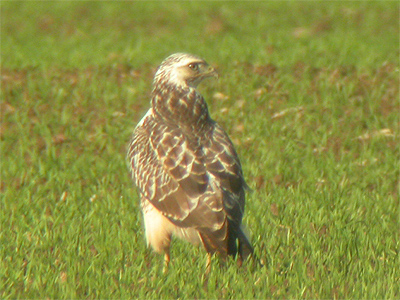 |
Throughout the year,
daily counts of resident birds numbered between one and
four. Definite Spring passage occurred on March 14th,
with five coming over from the south-west and continuing
north and north-east, then a group of seven high
south-east (April 27th) followed a few days later by
another three high south-east on April 29th. More migrants occured during the Autumn, when the resident population was augmented by migrant/dispersing birds, with counts of six over Red Hill on August 21st, a record 17 were over Red Hill on September 13th, with 11 a few days later on September 18th. Numbers remained above average during early October, with six noted on October 5th. Two juvenile birds often frequented fields opposite Eakring Field Farm during the month, including one distinctive pale bird. |
|
| ......... | ||
| Kestrel Falco tinnunculus |
| Common, with three pairs breeding at well spaced locations within the area. |
| ......... |
| Merlin Falco columbarius |
| One record which fitted in well with previous Merlin records here, of a female flying west over Eakring Flash and Red Hill on March 29th. |
| ......... |
| Hobby Falco subbuteo |
| There were no records during the whole of the Spring and early Summer periods. The first of the years was one at Eakring Flash on August 23rd, followed in September by singles moving through on 1st, 13th, 18th and 20th, with two at Eakring Field Farm (2nd) and two further single birds both on the 14th. |
| ......... |
| Peregrine Falcon Falco peregrinus |
| A total of ten records throughout the year. Single sightings of adult males on January 13th, February 2nd and March 15th could all have been attributable to one bird. A female was over Eakring Flash on April 5th, with another (or possibly the same) over Penny Pasture Common on April 12th. Following the breeding season, a juvenile female landed in fields at Park Farm, before flying off east over Hare Hill Wood on August 30th and was seen again on September 1st. A juvenile male flew south-west on September 1st, whilst an adult male was in the Park Farm and Hare Hill Wood area on October 18th. The year's final record, concerned one over Eakring Flash on December 24th. |
| ......... |
| Red-legged
Partridge Alectoris
rufa |
| Common and widespread, with numbers swelled by released birds. |
| ......... |
| Grey Partridge Perdix perdix |
| A record seven breeding pairs were located during survey work in the Summer, although no large coveys were recorded over the year. Grey Partridge are not released here for shooting purposes. |
| ......... |
| Pheasant Phasianus colchicus |
| Very common, with numbers swelled enormously by birds released for shooting purposes. |
| ......... |
| Water Rail Rallus aquaticus |
| The early part of the
year saw Water Rails hard to find, with the first being
at Eakring Sewage Treatment Works on January 12th, before
another appeared at Eakring Flash from 19-26th. During
February, singles were again at Eakring Flash on 2nd,
10th and 13th, with one present at the unusual location
of Penny Pasture Common on 28th. A late bird was present
and calling at Eakring Flash on March 6th and 26th. The first arriving bird of the Autumn period, was a single at Eakring Flash on September 27th and October 30th. There was an increase during November with two at Eakring Flash (6th) three from November 13-15th, then two continuing to be present after the 15th. Only one Water Rail was present at Eakring Flash all December. |
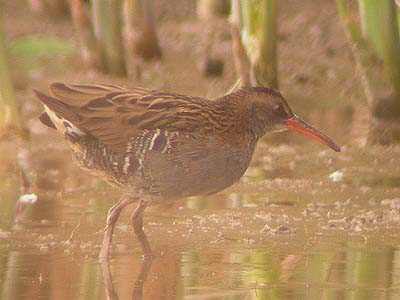 |
|
| ......... | ||
| Moorhen Gallinula chloropus |
| A total of 11 pairs were present during the breeding season, with all waters holding at least one pair. |
| ......... |
| Coot Fulica atra |
|
| One arrived at Eakring Flash on January 20th, with four appearing there on January 26th, although these were present for just a single day. With a total of eight pairs attempting breeding, the population remains stable here. Typically, there were no records after July. | |
| ......... |
| Oystercatcher Haematopus ostralegus |
| Two records, with a pair present in set-aside in the Red Hill area on May 10th, then one south-west over Eakring Flash on May 15th. |
| ......... |
| Golden Plover Pluvialis apricaria |
| After just odd single
fly-over birds during January, a flock of approximately
198 at Church Hill and Tug Bridge Farm on February 17th,
provided the best count for some time here. Wintering
numbers of Golden Plover have dropped in recent years and
although 950 were over Red Hill on March 27th, these
birds only appeared in the recording area, when flushed
from their regular site near Rufford. Three moving west (July 26th) and one moving north-west (August 16th) were the first Autumn record. The only records involving more than five birds throughout the rest of the year, were of seven at Park Farm on September 28th and 33 at several sites in the area on the October 30th. |
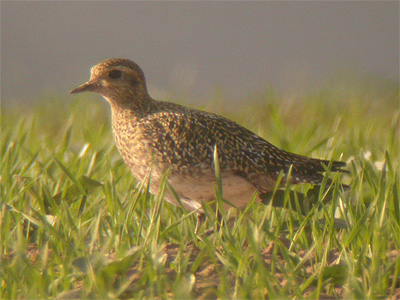 |
|
| ......... | ||
| Lapwing Vanellus vanellus |
| No over-wintering birds
meant that 97 moving south-west on January 3rd, was a
total that would not be bettered throughout the rest of
the year until a count of 257 on December 6th. A record 16 pairs occupied territories in the Red Hill, Park Farm and Kersall areas. At Park Farm, many of the 12 pairs nested on the recently created grass areas, but nesting was by no means confined to these. |
| ......... |
| Dunlin Calidris alpina |
|
| One was heard on nocturnal passage over Lound Wood during a moth-trapping session there on July 1st. | |
| ......... |
| Jack Snipe Lymnocryptes minimus |
| Penny Pasture Common again provided all the year's records, with a single there on February 13th and two on March 29th. The first of the Autumn was the area's earliest by a day on October 9th and remained for the rest of the month. Three were present on November 15th, but only one remained by November 21st and was seen throughout December, with two found again on December 11th. |
| ......... |
| Common Snipe Gallinago gallinago |
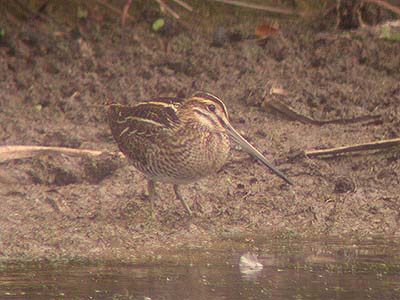 |
After low counts from the
latter months of 2007 continued into January 2008,
numbers rose from just four at Eakring Meadows on January
1st, to a more respectable 19 on January 19th. During
early February, there was an influx into the area on
(2nd) with 42 at Eakring Meadows being the highest count
here since February 2002. 18 were still at Eakring
Meadows on March 15th, rising to a minimum of 30 birds on
March 29th. The first returning Autumn bird was one at Penny Pasture Common on August 21st, with singles moving south-west on September 14th, 18th and 27th, then two north over Eakring Flash on 28th. 20 were at Eakring Meadows on November 21st, with an increase in December, when 32 were at both Penny Pasture Common and Eakring Meadows on December 11th. 21 were again at Eakring Meadows on December 24th. |
|
| ......... | ||
| Woodcock Scolopax rusticola |
| Singles were present at Hare Hill Wood on February 9th and then another the next day at Penny Pasture Common on February 10th. What was possibly the same bird, was seen flying onto Penny Pasture Common at dusk on the February 17th. |
| ......... |
| Whimbrel Numenius phaeopus |
| In Spring, four flew west over Eakring Flash on April 24th, followed by another high west over Eakring Flash on April 27th. One west over Eakring Flash on July 24th, was the only Autumn record. |
| ......... |
| Curlew Numenius arquata |
| Singles moving north over Red Hill on April 3rd and over Eakring Flash on June 7th, were the only records. |
| ......... |
| Green Sandpiper Tringa ochropus |
| There were no Spring records. During the late Summer/early Autumn, single birds were heard nocturnally over Lound Wood on both August 8th and August 10th. Sightings during daylight hours were one at Penny Pasture Common on August 16th, two at Eakring Flash on August 21st and singles at Penny Pasture Common on September 11th and 14th. |
| ......... |
| Common Sandpiper Actitis hypoleucos |
| A very late bird headed north over Lound Wood at 21:55h on May 28th and could possibly have spent the day at Eakring Flash, but there had been no daylight visits to confirm this. Two other records helped comprise a good year for Common Sandpiper, with one at Eakring Flash on July 24th and one heard on nocturnal passage over Red Hill on August 12th. |
| ......... |
| Black-headed Gull Larus ridibundus |
| Very common, with a count of 70 on January 12th being the best of the year. |
| ......... |
| Common Gull Larus canus |
| There were some excellent area counts during the early months of the year, with peaks of 43 in the area on January 5th, 53 on January 13th and 68 at Eakring Flash on January 19th. The only other count of note, was of 18 on February 16th. |
| ......... |
| Lesser
Black-backed Gull Larus fuscus graellsii |
| As always, the largest counts came during the late Summer and Autumn period. An extremely notable 700 in fields at Eakring Flash on August 29th, was later made look ordinary with a maximum of 1 200 in fields around the Leyfields area on September 20th. |
| ......... |
| Herring Gull Larus argentatus |
| Peak numbers occured during January with 36 in the area on January 5th and 115 at Tug Bridge Farm on January 20th. |
| ......... |
| Yellow-legged
Gull Larus
cachinnans michahellis |
| There were no records
until August, with sightings of three (two adults and a
2cy) in fields in the north of the recording area on
16th, an adult south and an adult and a 2cy in fields in
the Red Hill area on 21st, one in fields east of Eakring
Flash with 700 Lesser Black-backed Gull on 29th, before
an adult in fields near Wellow on 30th. September saw two records with an adult at Eakring Field Farm (21st) and five adults in fields in the Red Hill area (25th) October saw a further two records, with a 2cy bird in fields at Church Hill on 2nd and an adult and a 3cy in fields at Eakring Flash on 11th. |
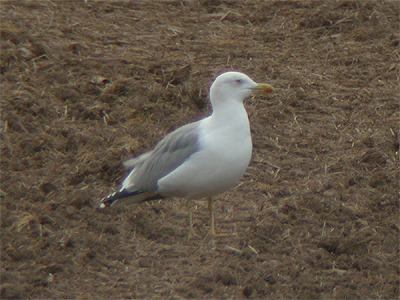 |
|
| ......... | ||
| Iceland Gull Larus glaucoides |
| An adult was at Eakring Flash on January 5th, present in fields with 36 Herring Gull, till they all flew off south-west towards Bilsthorpe Tip. This represented only the third record of Iceland Gull here, the last being another adult seen on both December 31st 2000 and January 1st 2001. |
| ......... |
| Great
Black-backed Gull Larus marinus |
| Generally a poor year. 31 on January 12th was the only notable count. |
| ......... |
| Feral Rock Dove Columba livia |
| Present throughout the year. |
| ......... |
| Stock Dove Columba oenas |
| Eight pairs were recorded breeding, but this could well have been an underestimate. Outside the breeding season, the largest count was of 13 in set-aside along the Kneesall Road on March 8th. |
| ......... |
| Wood Pigeon Columba palumbus |
| Northerly moving migrants were difficult to detect from birds on feeding flights during the early months of the year. February saw 80 migrants move through and of a total of 183 in March, 164 of these moved north on March 27th. A breeding population of 33 pairs was found during the Summer. Autumn movements were confined to October and included 2 254 south on October 30th. |
| ......... |
| Collared Dove Streptopelia decaocta |
| Common around all sites of human habitation, with an increase in breeding numbers from the 1998 survey. A total of 20 pairs were found in 2008, with many of these at various sites around Eakring village. |
| ......... |
| Turtle Dove Streptopelia turtur |
| One on April 21st was a very early record. There were few Spring migrants and just two pairs bred during the Summer. There were better numbers during the Autumn, with 13 migrants recorded during September. |
| ......... |
| Barn Owl Tyto alba |
|
| Away from the breeding season, a single was hunting set-aside strips near Eakring Field Farm on February 17th and would often show stunningly well most evenings during the latter part of the April. Two pairs were present during the breeding season, both nesting in artificial nest boxes. | |
| ......... |
| Little Owl Athene noctua |
| The area's breeding population remains constant, even after 11 years observation here. Three pairs bred at traditional locations. |
| ......... |
| Tawny Owl Strix aluco |
| More often heard than seen, with six pairs found in territory during the Summer months. |
| ......... |
| Long-eared Owl Asio otus |
| At least one bird was present in the same roost used by two birds early last year near Kersall from February 9-22nd and then throughout March, but two were present on April 1st. One (non-breeding bird) was also seen in daylight at Eakring Flash on both May 15th and 25th. |
| ......... |
| Short-eared Owl Asio flammeus |
| One was at Penny Pasture Common from September 13-14th and showed extremely well during it's stay. |
| ......... |
| Nightjar Caprimulgus europaeus |
|
| One flew over Lound Wood and headed south-west at 23:15h during a moth trapping session on May 20th and represented the second new species of the year for the Eakring area. The bird was obviously a passage migrant and was heard to call four times times at regular intervals as it flew over, each time producing a slightly unusually toned short 'churr'. Always thought of as being a likely species to turn up, Nightjar has never been specifically looked for as there is no suitable habitat. However, they were reported a few years ago by surveyors in woodland near Bilsthorpe. | |
| ......... |
| Swift Apus apus |
|
| The first of the year was on April 27th, with a succession of records until three September records of singles south on 1st, 2nd and 14th. There were no especially notable counts made during the year and most of the return migration was missed through work commitments. | |
| ......... |
| Kingfisher Alcedo atthis |
| Recorded fairly regularly, with most records occurring from July onwards, concerning either singles or two birds at Eakring Flash. |
| ......... |
| Green Woodpecker Picus viridis |
| Breeding was finally confirmed during the Summer, with a single pair raising young at Lound Wood. Birds were present at two sites in the area throughout the year. |
| ......... |
| Great Spotted
Woodpecker Dendrocopos
major |
| Recorded on most visits to the area, with birds often noted flying from Lound Wood to Eakring village to feed. Two pairs again bred at suitable sites. |
| ......... |
| Sky Lark Alauda arvensis |
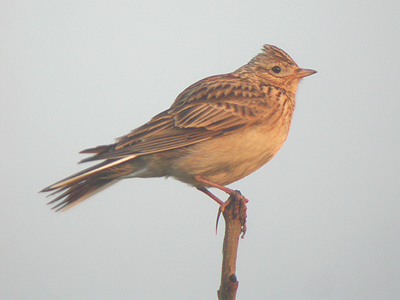 |
The Eakring population
continues to go from strength to strength, with a
remarkable increase in breeding pairs from ten back in
1998, to a total of 50 pairs this year. To confirm this
total, counts were made on several occasions during the
breeding season. Much of the area is now well occupied by Sky Larks and their spread across the area has generally been eastwards, although there is still a distinct lack of breeding pairs in areas to the north and north-east of Lound Wood. During the Winter months, a count of 80 in stubble fields at Red Hill on January 3rd, was a record. |
|
| ......... | ||
| Sand Martin Riparia riparia |
| Two moving north-west over Hare Hill Wood on March 27th,followed by a single north-west on March 30th, were the first of the Spring. During April, 127 passed through, making it the second best April on record here. Much smaller numbers (30) were recorded during the Autumn, with migrants only passing through in July and September. |
| ......... |
| Swallow Hirundo rustica |
| The breeding bird survey
showed a dramatic increase in numbers, althrough this was
probably attributable to greater access to private sites
aand dwellings than in previous surveys. The actual
status of breeding Swallows here, has probably changed
very little since 1998. Spring arrival was from April 4th, with one of the area's breeding birds appearing at Eakring the next day. No significant daily or monthly counts were made. Autumn migration was quite pronounced this year, easily being the best for several years. September again proved to be the peak month, with 398 south on September 14th the best of the counts. There were two October records, with the latest date being October 16th. |
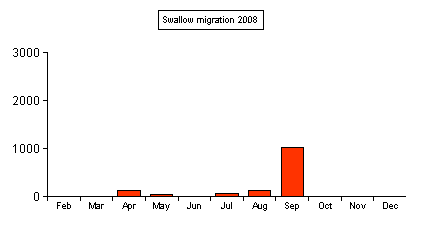 |
|
| ......... | ||
| House Martin Delichon urbica |
| Arrival from April 21st and a poor year for House Martin numbers recorded on visible migration watches, with Spring producing a miserable total of just 25 birds. 15 pairs were located during the year's breeding bird survey, indicating a stable population, mainly centred around Eakring village. Autumn migration counts were a little improved, but there have been no four figure counts here now since 2002. Although some of this can be put down to observer coverage, it seems likely that numbers have actually dropped. |
| ......... |
| Tree Pipit Anthus trivialis |
| In Spring, singles were
noted on three April dates with birds moving north-west
(17th) at Penny Pasture Common (19th) and at Eakring
Flash before moving off north-west at the onset of rain
(23rd) The Autumn produced further records of singles over Eakring Flash on August 14th and 16th,. one was present at Penny Pasture Common on August 19th and a group of three moved south over Eakring Flash on August 21st. There were three records during the first half of Seotember, with one at Penny Pasture Common (2nd) and singles south on 3rd and south-east on 14th. |
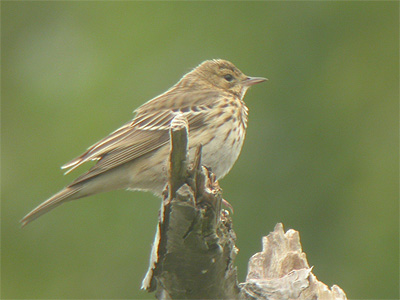 |
|
| ......... | ||
| Meadow Pipit Anthus pratensis |
| Visible migration watches produced the best Spring count since 2001, with a peak of 244 north-west on 27th. September produced all the best Autumn counts, although there was nothing exceptional. The best of the counts were 124 south on September 13th, 133 south-east on 14th, 335 south and south-east on 18th, 227 south-east on 20th and 212 south on 21st. A flock of 82 Meadow Pipits were held up at Eakring Flash by poor weather on September 28th. |
| ......... |
| Yellow Wagtail Motacilla flava flavissima |
| Three breeding pairs represented the highest number of breeding pairs ever here, with two of these found in the same locations as 2007. Arrival in Spring from April 17th and a poor total of just 23 Spring birds recorded, compared to an equally poor Autumn total of 34. Last of the year was one on September 14th. |
| ......... |
| Grey Wagtail Motacilla cinerea |
| A pair at Penny Pasture Common on April 20th and the next day at Tug Bridge Farm, gave hopes of a potentially breeding first, but there were no further records. Autumn proved to be very disappointing, with just five migrants through in September and October. |
| ......... |
| Pied Wagtail Motacilla alba yarrelli |
| Just 14 migrants were recorded in the Spring period, but numbers were better on Autumn passage, with a total of 79 birds. Numerous Pied Wagtails were grounded by poor weather in fields throughout the area on September 28th. Five pairs bred during the Summer. A short-lived roost at Eakring Flash reached a peak of 36 on November 13th. |
| ......... |
| White
Wagtail Motacilla alba |
| Spring records consisted of singles present in horse paddocks at Eakring on April 4th and at Penny Pasture Common on April 16th. The Autumn saw one record, of two in fields opposite Eakring Field Farm, before flying off south-west on September 28th. |
| ......... |
| Wren Troglodytes troglodytes |
| Very common. A total of 85 pairs were found during the breeding survey. |
| ......... |
| Dunnock Prunella modularis |
| Very common throughout the area with a total of 58 pairs found during the breeding survey and representing a large population increase on 1998 figures. An increase in the recording area is partly attributable to the rise in counts. |
| ......... |
| Robin Erithacus rubecula |
| Another common breeding species, showing a huge rise on 1998 survey counts with 95 breeding pairs. Part of the reason for this (though not completely) is the increase in recording area in 2008, compared to the survey in 1998. |
| ......... |
| Redstart Phoenicurus phoenicurus |
| There were two Spring records involving single males. One in the Sallow scrub along the western-edge of Eakring Flash on April 10th and along the new hedge at Eakring Flash on April 27th. The Autumn saw records of a 1st Winter male in the Hawthorns on Penny Pasture Common from August 30-September 1st. a female at Eakring Flash on September 2nd, a female at Penny Pasture Common on September 3rd and an unseen bird at Tug Bridge Farm on September 14th. |
| ......... |
| Whinchat Saxicola rubetra |
| This species is becoming
much less common here than formerly. The only Spring
passage bird was a male that arrived at Eakring Flash
around mid-morning of April 27th, but did'nt stay for
long before moving off. August and September provided the following records. Single birds at Eakring Flash August 21st and Penny Pasture Common August 24th. One arrived in company with a Redstart at Eakring Flash on September 2nd, whilst others were at Penny Pasture Common on September 6th and Eakring Flash again on September 11th. |
| ......... |
| Stonechat Saxicola torquata |
| 2008
represented an exceptional year, with 19 birds occurring
during the Spring period. When you consider that there
had never been any more than three Stonechat in a single
Spring here before, then the scale of this passage needs
little imagination. Three birds turned up on February 28th, with a male along the roadside between Eakring and Wellow and a pair along the boundary fence at Penny Pasture Common. A further 16 Stonechat appeared throughout March, with Penny Pasture Common providing eight of the month's Stonechat with five (four males and one female) there on 4th, followed by a male on the 6th and a male and female on the 19th. Two males were along roadside hedges near Eakring Field Farm on 29th, whilst roadside hedgerows near Wellow, produced a female on the 14th and a male on the 17th. Records from Eakring Flash included two males (14th) and females on both 15th and 29th. There were two Autumn records of 1st Winter birds at Eakring Meadows on September 27th and at the southern-end of Eakring Flash briefly on October 9th. |
||
| ......... |
| Continental Stonechat Saxicola
torquata ssp.rubicola |
| A Stonechat which showed
all the characteristics of the continental race known as
Continental Stonechat Saxicola torquata ssp.rubicola,
was present at Eakring Flash from early morning and
remained until dusk on April 23rd. It initially favoured a grass track and rough vegetation near Eakring Flash, but then relocated to the north-eastern corner of Eakring Flash, where it remained for the rest of the day. Stonechat has never before produced an April record here, with late Winter and early Spring records all falling between inclusive dates of February 21-March 29th. The occurrence of this bird came over three weeks later than all previous records, but did follow the exceptional Spring passage of this year. |
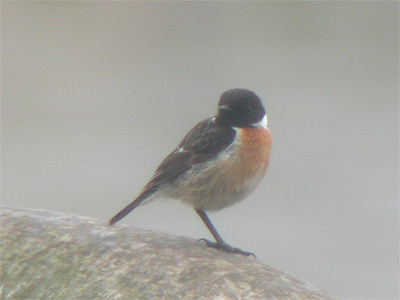 |
|
| ......... | ||
| Wheatear Oenanthe oenanthe oenanthe |
| The first of the Spring
was a male briefly at Eakring Field Farm on March 30th.
Single males were also in fields at Park Farm (April 2nd)
at Tug Bridge Farm (April 14th) and in fields at Kersall
(April 17th) Four arrived at two sites on April 10th,
with three males in fields at Park Farm and a female at
Red Hill. Two Autumn migrants appeared at Eakring Flash briefly on August 1st, whilst one arrived with a Whinchat at Eakring Flash on September 11th. |
| ......... |
| Ring Ouzel Turdus torquatus |
| Blackbird Turdus merula |
| Approximately 163 pairs were found during the 2008 breeding bird survey, representing a large increase on previous surveys. There were no notable influxes during the Autumn months. |
| ......... |
| Fieldfare Turdus pilaris |
| There were fairly good
numbers present during the first months of the year, with
a minimum of 200 at Park Farm on January 1st and 273 at
Tug Bridge Farm on January 16th. 63 Fieldfare north-west
and north-east February 17th, were possibly very early
migrants, preceding 53 moving north-east on March 24th.
Groups were noted throughout April, either leaving high
to the north-east at dusk, but also at Tug Bridge Farm
and Penny Pasture Common. A group of 12 Fieldfare at
Penny Pasture Common remained from April 19-23rd. Best movements of the Autumn were 1 146 moving west and south-west on October 18th and 169 south-west on November 13th. |
| ......... |
| Song Thrush Turdus philomelos |
| Breeding numbers continue to show an increase here, with an area total of 33 pairs breeding this year. Small numbers of migrants were noted in September and October, but there was no obvious influx of continental birds. |
| ......... |
| Redwing Turdus iliacus |
| As usual, there were only
small numbers found during the early part of 2008. A
group of 30 were at Tug Bridge Farm on January 16th, then
26 at Eakring Meadows on April 2nd. The last record of
the Spring was with a small group of Fieldfare and a
female Ring Ouzel at Penny Pasture Common for a few days
till April 21st. A relatively ordinary Autumn migration followed later in the year. The first returning birds were a single high over Eakring Flash on September 25th and three at Eakring village on September 28th. A migration peak of 1 107 Redwing west and south-west on October 18th, was part of an October total of approximately 2000 and included 450 south-west on October 16th. Small numbers were recorded moving in November, whilst December counts on the ground were typically very small. |
| ......... |
| Mistle Thrush Turdus viscivorus |
| A resident breeding population of eight pairs were found during the breeding bird survey. |
| ......... |
| Grasshopper
Warbler Locustella
naevia |
| There were ten birds, which all arrived from April 21st onwards. Reeling males were recorded from Red Hill, High Trees, Eakring Flash, Eakring Meadows, Penny Pasture Common and Tug Bridge Farm. During May, pairs were present at Eakring Flash, Tug Bridge Farm and Penny Pasture Common, with confirmed breeding at all three sites. |
| ......... |
| Sedge Warbler Acrocephalus schoenobaenus |
| First of the year arrived at Eakring Flash on April 24th, with three arriving on April 27th. A Spring total of 12 was notable here. Return migration was noted in August, with single birds at Eakring Flash on three dates. |
| ......... |
| Reed Warbler Acrocephalus scirpaceus |
| The first returning bird was back at Eakring Flash on May 15th, with a second arriving a week later on May 22nd, then a third turned up on May 25th. Breeding was confirmed at Eakring Flash during June, with a pair noted feeding young. No Autumn migrants were recorded. |
| ......... |
| Lesser
Whitethroat Sylvia
curruca |
| 2008 represented an excellent year, with a total of 42 birds recorded over the Spring and Autumn. Arrival commenced from April 22nd and a record 11 pairs bred in the area during the Summer. Return migration was noted from mid-July onwards, peaking during August and September. A Lesser Whitethroat at Eakring Flash on October 2nd, was the latest ever record here. |
| ......... |
| Whitethroat Sylvia communis |
| Arrival from April 21st with one at Eakring Flash, with main arrival of returning breeders being from April 24-27th. Birds continued to arrive well into May. A healthy total of 44 breeding pairs were present during the breeding bird survey. Autumn migration was noted from July to September, with a typical peak in August. |
| ......... |
| Garden Warbler Sylvia borin |
| First of the year arrived on April 30th. During May, more new birds arrived leading to a breeding pair count of four pairs during the Summer months. There were no Autumn records. |
| ......... |
| Blackcap Sylvia atricapilla |
| Spring arrival was from April 7th at Eakring Meadows. Singing males became much commoner after April 25th, following a period of windy weather which held up many migrants. A breeding count of 39 pairs were present during the Summer. Last of the year were two at Eakring Flash on October 2nd. |
| ......... |
| Chiffchaff Phylloscopus collybita |
| The first singing males of the year were two in Eakring village on March 27th, with four arriving at High Trees on March 29th and a single at Eakring Meadows on March 31st. There was an increase in breeding pairs this year, with 32 pairs found. Autumn migrants were noted from late July and reaching a good peak of 92 birds in September. Last of the year was a single bird at Eakring Flash on October 5th. |
| ......... |
| Willow Warbler Phylloscopus trochilus |
| Spring arrival from April 10th, with one at Eakring Flash, but Willow Warbler numbers were very low throughout Spring this year, leading to just eight breeding pairs across the area. Decent numbers were recorded on return migration, with a peak being reached in August. Late records included single birds at Tug Bridge Farm on September 14th and Eakring Flash on September 18th. |
| ......... |
| Goldcrest Regulus regulus |
| The area's breeding population rose to four pairs centred around Eakring village and Lound Wood. A typical number of migrants were noted moving through during the Autumn, with a peak of 24 occurring in September, although movement continued throughout October. |
| ......... |
| Spotted
Flycatcher Muscicapa
striata |
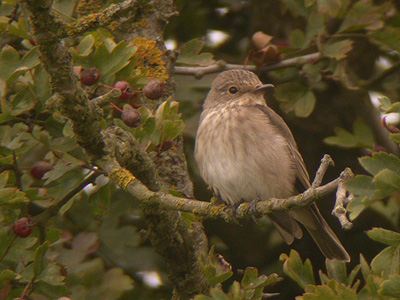 |
The only Spring birds
were a pair which arrived in late May (25th) at a site in
Eakring village, where they eventually nested in a hole
in the wall of an old outbuilding. A few migrants were noted on passage during the Autumn, including singles in the pastures area on August 24th and at Penny Pasture Common on August 29th. There were two September records, when one was at Penny Pasture Common on September 13th and two in trees at Red Hill on September 14th, a date which coincided with Spotted Flycatchers turning up at several other Nottinghamshire sites. |
|
| ......... | ||
| Long-tailed Tit Aegithalos caudatus |
| Common, with 11 breeding pairs found during the breeding bird survey. |
| ......... |
| Marsh Tit Parus palustris |
| Uncommon in the Eakring area, with just single pairs again breeding at Lound Wood and Hare Hill Wood. |
| ......... |
| Willow Tit Parus montanus |
| Three breeding pairs made Willow Tit only slightly commoner than Marsh Tit, with single birds or pairs more frequently found at sites away from breeding sites within the recording area during the year. |
| ......... |
| Coal Tit Parus ater |
|
| Has never been a common breeder here, but the single pair found during the breeding survey, was the lowest count to date. A few migrants were recorded from August-October, with a samll peak occurring in September. | |
| ......... |
| Blue Tit Parus caeruleus |
| Very common with 25 pairs breeding. |
| ......... |
| Great Tit Parus major |
|
| Common with a count of 20 breeding pairs. | |
| ......... |
| Nuthatch Sitta europaea |
| One or two birds were present at Lound Wood from August 26-October 16th. |
| ......... |
| Treecreeper Certhia familiaris |
| Uncommon away from breeding sites at Lound Wood and Hare Hill Wood, where four pairs bred this year. |
| ......... |
| Jay Garrulus glandarius |
|
| A single pair bred at Lound Wood (first confirmed breeding since 2000) Spring migrants consited of five birds seen during April and there was just one Autumn record this year. | |
| ......... |
| Magpie Pica pica |
|
| Common, with eight breeding pairs present. | |
| ......... |
| Jackdaw Corvus monedula |
| Very common with daily records. A breeding population of 19 pairs across the area. |
| ......... |
| Rook Corvus frugilegus |
| The area population remains stable, with 60 pairs breeding. Large numbers were seen daily, but no actual counts were made this year. |
| ......... |
| Carrion Crow Corvus corone corone |
| A total of 15 nests were occupied during the year. Two strikingly marked young birds with white primaries and secondaries, spent several weeks in the Eakring Field Farm area during the Autumn. |
| ......... |
| Raven Corvus corax |
|
| Raptor watching from the top of Red Hill provided two flying low south on September 20th. This was a first record for the area and one that was long overdue, especially given the number of Raven sightings in Nottinghamshire in recent years. | |
| ......... |
| Starling Sturnus vulgaris |
| The first months of the
year provided few notable counts. However, 105 south-east
on January 19th, was an unusual record given the time of
year. Return migration peaked with 74 east over Eakring
Flash on February 13th and 124 east on March 26th. The
number of breeding pairs was found to have dropped during
the year's breeding bird survey to just 13 pairs, after
having a stable population since 1998-2007. First Autumn migrants were noted on October 9th. 193 flew west on October 19th, before numbers peaked at 1 090 west on October 30th. 148 flew south-west on November 13th. |
| ......... |
| House Sparrow Passer domesticus |
| Since 1998 when this
species was first surveyed, House Sparrow numbers have
remained fairly consistant and efforts were made to
establish whether numbers throughout the Eakring area had
declined in line with recent national statistics. A population survey on January 19th produced a count of 130 birds, with birds found in varying concentrations. Small numbers of birds were found at seven sites and these presumably join with larger groups on and off throughout the day, away from the breeding season. Peak counts of groups containing more than ten birds, came from six areas within the village, with four of these groups being near farm buildings or the village's older properties. The breeding bird survey produced a count of 67 pairs. This figure is slightly down on all other breeding surveys. |
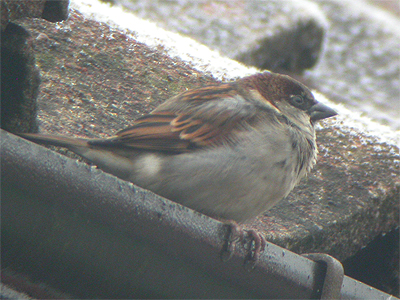 |
|
| ......... | ||
| Tree Sparrow Passer montanus |
| Six breeding pairs occupied territories at three areas/sites during the Summer, the largest total since recording began here. Several good sized post-breeding flocks included 35 at Tug Bridge Farm on August 21st, 47 at Penny Pasture Common/Eakring Field Farm on September 11th and 20 along hedgerows at Red Hill on September 18th. |
| ......... |
| Chaffinch Fringilla coelebs |
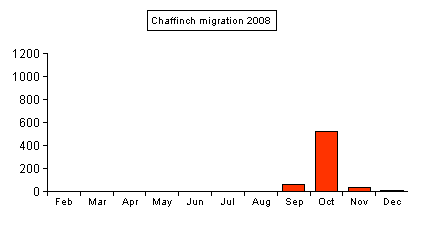 |
Very common throughout
the year, with a total of 110 pairs present during the
breeding season. Autumn migration was pronounced and recorded each month after the first moved through in September. Highest numbers of Chaffinches moved through during October, with a new record day count of 120 through mostly west on October 18th, followed at the end of the month by a further 119 through on October 30th. The October total of 526 Chaffinches, was the highest ever monthly total, just beating the previous monthly record count of 522 back in October 2001. Most movement was westerly and birds generally high. |
|
| ......... | ||
| Brambling Fringilla montifringilla |
| One at High Trees
(Eakring village) on January 12th provided a rare Winter
record and two were at Eakring Flash briefly on February
28th, just minutes before a flock of 22 flew high north.
Last of the Winter/Spring period was a single with a
mixed flock of finches at Park Farm on March 6th. There was a very poor showing during the Autumn and the only records were one moving west (October 30th) and singles through on November 13th, 16th and 21st. |
| ......... |
| Greenfinch Carduelis chloris |
| Common with 18 pairs breeding. Eakring and Kersall villages held most breeding pairs, with breeding birds rare away from these areas. Visible migration counts were generally poor although northerly movement was detected during March and April in the Spring. Autumn migration peaked at just 43 birds for the whole of October, but movement was detectable into November. |
| ......... |
| Goldfinch Carduelis carduelis |
| Spring migration was noted most days during April, but small numbers of migrants were recorded from February until May. Autumn counts were relatively low, with an earlier peak coming in September this year. 15 pairs bred, indicating an inreasing population on 1998 figures. |
| ......... |
| Siskin Carduelis spinus |
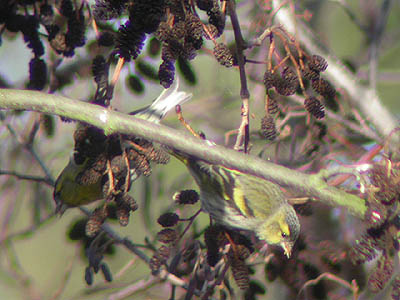 |
An early influx occurred
during September, producing the best monthly total since
October 2001. Four birds on September 1st were the earliest ever here and migrant Siskins were subsequently noted on many September dates. A monthly total of 178, included 35 south (13th) 59 south-east and south-west (14th) and 20 south (21st) Smaller numbers continued to move through in October, with very small numbers in both November and December. |
|
| ......... | ||
| Linnet Carduelis cannabina |
| A flock of 100+ at Park Farm on March 6th, indicated that northerly migration was well underway, but visible migrayion counts saw a typical peak in April. During the Summer months, 19 breeding pairs were located across the area. Autumn migrants were recorded each month from August through to December, with peak monthly totals of just 103 in September and 154 In October. A flock of 50 were near Penny Pasture Common on December 24th. |
| ......... |
| Twite Carduelis flavirostris |
| A single flew east over Eakring Flash at 08:13h on November 15th and was the first record since 2001. |
| ......... |
| Lesser Redpoll Carduelis cabaret |
| There were no Lesser Redpoll records at all until the first of the Autumn in September. Monthly counts were small and there was no influx as per Siskin. Autumn migration peaked in October, with a total of 46. |
| ......... |
| Common Crossbill Loxia curvirostra |
| An excellent series of records throughout the year. Three flew north over Eakring Flash on the afternoon of March 26th, but there were no further records until two high north-west over Eakring Flash on July 26th and one north over Lound Wood on August 24th. Additional records were one low south-east over Eakring Flash on September 6th, seven north over Eakring Flash on October 5th and four south over Eakring Flash on October 16th. |
| ......... |
| Bullfinch Pyrrhula pryyhula |
| An increase in the number of breeding birds, with a total of nine pairs in the area. Throughout the year, Bullfinches were seen on numerous dates and favoured locations were Eakring Flash, Oil Bore Holes (Eakring village) and Eakring Meadows. |
| ......... |
| Hawfinch Coccothraustes coccothraustes |
| Two flew north over Eakring Flash, heading towards Lound Wood on April 6th. Second area record. |
| ......... |
| Yellowhammer Emberiza citrinella |
| Common and recorded daily throughout the year. The highest single count came very early in 2008, with a flock of 40 in stubble fields at Red Hill on January 3rd. A total of 38 pairs bred. |
| ......... |
| Reed Bunting Emberiza schoeniculus |
| Common with a breeding population of 16 pairs, centred largely around Eakring Flash and Eakring Meadows. |
| ......... |
| Corn Bunting Miliaria calandra |
| One flying east over Eakring Flash on April 27th, was the first Corn Bunting here for five years. |
| ......... |